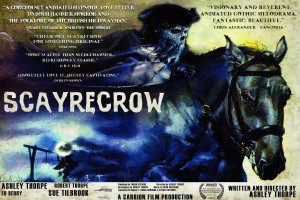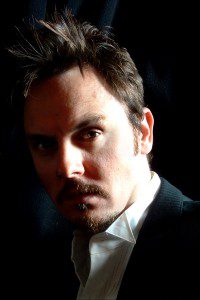When was the first time you watched a horror film, and how did it affect you?
My first horror film was a late night screening of The Devil Rides Out. I was tiny. My Mum had always been a fan of ghost stories and horror and as my Dad worked away from home a lot she quite often used to keep me up late for company, so I got to see all manner of the tamer stuff from a young age.
The first horror film that really shook me was Alien. That’s a very vivid memory. I think it must have been the UK TV premiere and still in the rapture of Star Wars. I was allowed to stay up and watch it believing Alien to be an effects driven romp in a similar vein. I still remember the growing pit in my stomach as the film unfolded. It was as if everything I had been led to believe was ‘violated’. And though it was a terrifying experience, it was also very seductive. Alien is a very gothic film. There was something almost religious, cathedral-like about the derelict ship and Giger’s radical imagery felt like some sort of evolutionary trespass. Needless to say, I had nightmares for weeks and, as a consequence, I have been a huge fan of both Giger’s work and the film ever since!
What was it that first attracted you to horror?
I had always loved monsters in all their shapes and sizes but initially I could not stomach horror at all. As a child I suffered from night terrors, literally dreams that I could not awake from. That line in Pink Floyd’s The Wall – “When I was a child I had a fever, my hands felt just like two balloons…” – that was exactly how it used to feel when these trances came on. I have since found out that my Dad suffered from the exact same dreams in his youth. At first these ‘unbreakable’ nightmares made me shun horror. I was quite simply too frightened to invite feelings that. Unlike others I thought I wouldn’t be able to walk away from – even the opening score to a film might send me into a shaking fit. But in time I grew to make ‘a friend of horror’. I started reading Fangoria magazine and seeing how effects were created, started reading about artists who ‘wielded’ this weapon and the history of the genre that had brought me to my knees, all the usual suspects initially, but my reading, indeed hunger for this sort of material, soon became very eclectic and in time veered very heavily towards the gothic. Hammer in particular became a passion during this time because I loved the arch romance of it all.
Although still very much ‘wary’ of horror I remember key moments of attraction or at least intense curiosity. I remember seeing the cover to Iron Maiden’s Killers and finding that marriage of a grinning ghoul within a modern urban – specifically working class – sodium-soaked landscape a revelation. I remember coming face-to-face with Jack the Ripper in the shadows of ‘the Chamber of Horrors’ at Madame Tussauds and I can vividly recall a telling of the Dartmoor myth of ‘The Hairy Hands’. In fact I was surrounded by local myths and ghost stories and elderly couples eager to tell them! It seemed like an inevitability that most social get togethers (especially at a pub) would end with a grisly ghost story or two. Though I initially dreaded these chilling stories (in fact I’d often go and hide in the toilet until they were over) I now feel very lucky to have been ‘exposed’ to these stories as they’ve come to inspire and influence pretty much my entire body of work.
What achievement are you most proud of?
Outside of raising two amazing children with an amazing wife on a shoestring (being a filmmaker/artist will do that to you), I suppose I’m proud of making a series of uncompromising films – shorts thus far – that have been seen across the world and made purely by a desire to see new British gothic horror material. I was initially the sad ranting lone voice in the wilderness (pre Woman in Black) who was bombarding message boards and writing emails to Hammer scolding them for ignoring the tradition (ignored of course). That such a diverse international audience have embraced these very modest little things to such an extent, and urged me to do more, that obviously makes me very proud. And of course I am very proud that my animations led to Chris Alexander giving me the chance to contribute to Fangoria! So a proud fifteen year old as well as a proud forty year old dad.
I have just finished another classic horror style radio play following on from my previous effort The Demon Huntsman for Glass Eye Pix project Tales from Beyond the Pale. It’s still quite gothic but a bit more playful this time, a bit more EC comics.
In terms of film we’re just about to launch a kickstarter project to get our next Carrion Film animated short, Borley Rectory, into production. This will be my take on the house and the Price investigations within it, something very textural, not so much the definitive examination of the story, but rather a vivid expression of why this particular haunting and hauntings in general fascinate. It’s a story that I first encountered in the Usborne book of Ghosts in my school library and I want to try and express those initial enthusiasms visually. We’ve been working on pre-production and Julian Sands recorded the films narration earlier in the year so, though production was initially delayed by being stuffed about by a number of British funding bodies (that shall remain nameless), we’re confident with the assistance of crowdfunding that Borley Rectory will rise again soon.
My long term project is Spring Heel Jack – a Dickensian horror story – as opposed to the more familar later period that sired Sherlock Holmes, Jekyll & Hyde and the Ripper crimes – and is inspired by the ‘genuine’ boogeyman from the early 1800s. The tale of a rooftop bounding demon that could appear and disappear at will caught hold of the public imagination becoming in time a popular character in Victorian fiction, in particular the Penny Dreadful’s (popular working class fiction) of the period who took the figure and transformed him from a shilling shocker phantom into an embryonic super-hero. With his crime fighting exploits bedecked in bat-like cloak and horned cowl it is difficult not to see him as anything other than the template of what would become Batman.
I have been fascinated by the myths of Spring Heeled Jack since I was a child and have often wondered why his presence on film has been so negligible. Having spent the last few years obsessively writing and animating a series of scripts and animated short films inspired by neglected aspects of British folklore (Highwaymen, Screaming Skulls, Dartmoor Legends), films which have in particular caught the imagination of the American market. I believe that exploring the myth of Spring Heel Jack in feature length is the next logical step. These legends are an essential part of our British cultural identity and I believe that they should be celebrated, revitalised and shared.
Apart from it being a delicious bit of British esoterica, the story fascinates me because it occurs in a period that has thus far pretty much only been defined by Dickens. I believe it is a period ripe for re-evaluation as a setting for the macabre. It presents itself not only as an opportunity to explore early Victoriana (at a time when genre templates for horror and detective tales were coalescing in popular fiction) but a chance to make something akin to a classic ‘Hammer Horror’ with an edge. The script is currently in development and I have started pre-production character and concept art.
Who do you admire in the horror world?
That’s a difficult one. I still have huge admiration for people like Stephen King, Clive Barker, John Carpenter and David Cronenberg but I still attribute these names as heroes of my youth. Nowadays I suppose I admire people like Larry Fessenden and Terry Gilliam, tenacious yet adaptable artists with an independent spirit who attempt creation without compromise, well beyond that which any attempt to turn words into images necessitates. I have huge admiration for teams beyond the likes of the League of Gentlemen and I though what Shearsmith and Pemberton did with Psychoville was wonderful. I actually admire a wealth of people; painters, composers, actually especially writers these days, as writing is something that I still find particularly challenging.
 Do you prefer gore or psychological horror?
Do you prefer gore or psychological horror?
I think there’s a place for both in horror and I think both perform different functions. I always found Clive Barker’s early work interesting on that score. Look at Candyman for instance. Hellraiser too, actually. Though it’s gore-soaked I still find the deviancy of the ideas in Hellraiser (another gothic) far more challenging than the grue. I’m still partial to a bit of the old splatstick but in terms of my own work it’s definitely psychological horror. My enthusiasms actually are almost exclusively gothic these days with the animations very much inspired by Hammer and the Amicus portmanteaus. Perhaps I yearn for a little romance with my horrors.
How important is it to unsettle a viewer?
As much as horror’s role in the twenty-first century seems to be primarily to entertain, I think there’s an unspoken contract made between creator and audience that the emotions that the creator is seeking to elicit will always be negative, specifically targeting the audience’s primal fears, beliefs or perhaps even guilt. I think the audience expects and deserves to be unsettled. It’s scratching at the surface of their perceptions to announce that the landscape is about to change into unfamiliar or perhaps all too familiar nightmarish climes. It’s the very essence of tension – the journey into the unknown.
How do you evoke fear?
I’m not entirely sure that my own work is particularly frightening, but then ironically I’m probably not the best person to ask. I don’t see Scayrecrow, for instance, as a particularly frightening film. I would say that it’s rather a charming little adventure dressed in the robes of horror. The Hairy Hands, however, uses tried and tested Hitchcockian devices of the audience having greater knowledge of an event than the protagonist played out against an environment of universal primal dread – an isolated spot with the unsettling fear that you are not alone. The Screaming Skull was much more of a meditative approach.
After the Hammer bombast of Scayrecrow I attempted to create something Jamesian – a slow building of atmosphere with a nicely managed crescendo. We are introduced to Spencer the battle torn protagonist, he explores the house, the ghostly presence makes its presence known, unobtrusively at first then with greater insistence until it holds centre stage and destroys the protagonist. It’s archetypal M.R James in its construction really. Though apart from all the talk of spirits I did want The Screaming Skull to have these strong implications and visual undercurrents relating to mental illness and family abnormality. What is interesting however is although reception to both Scayrecrow and The Hairy Hands has been almost universally positive, reaction to The Screaming Skull was quite divided – everything from a damning review in Gorezone to a Best UK Short Film nomination at Raindance. Doesn’t get much more polar than that!
What scares you?
I used to think that nothing that scared me as a child scares me anymore, but writing the feature has made me doubt that somewhat. Though I think I absorbed much of it into my work, glimmers remain. Not only have I had the odd moment in the dark recently where I could have sworn that I could see some amorphic shape pulling itself from the corners of the room in the middle of the night, I also used to be terrified as a child that there was a shadowy figure that lived on the rooftops of our terrace that would chase me home at night, all the way to the door, and I’ve caught myself glancing up at the chimney stacks again on my night walks home again. Of course all of this has naturally gone into Spring Heel Jack. It sounds a little like a cliche but the material that really terrifies me now as a husband and a father are things like Pet Sematary and even The Shining – family related horrors either involving the loss of family members or the loss of control of a parent that endangers the loved ones he is sworn to protect. I find those very difficult.
Why should people watch your films?
Because they’re British, they’re independent and they’re made with heart and a sincere love of the genre. And because I sincerely hope that you will like them!
Cultures may change in time and place, but the roots of culture remain the same. Like any story they exist through their telling and many of those stories told to me as a child just aren’t being told anymore. Many folk stories and communal legends once integral to the fabric of a regional, and perhaps national, identity are being lost because they are simply not being passed from one generation to the next.
Each of my films/scripts draws from neglected local legends and aspects of regional mythology or characters from the early Penny Dreadful’s. Some were once part of a shared English mythology, such as The Hairy Hands, but have since slipped into obscurity outside the region that spawned them. I believe that the diversity of these tales lies testament to the richness of our folklore’s heritage and I aim to do my little bit to celebrate that.
A local review for the animations summarised thus: “freaky folklore just got rebooted for a new generation.” I rather liked that.
 How far is too far when it comes to horror cinema?
How far is too far when it comes to horror cinema?
Horror has always been at the forefront of testing the boundaries of taste and decency. It is the essence of the forbidden and all that we fear. Cinema of the extreme isn’t really my taste any more but that doesn’t mean that I’m a prude or censorious at heart. I am actually constantly surprised at how upset viewers, actually critics, become at material like The Human Centipede and A Serbian Film. I always come away from these films feeling slightly grubby. Not because of what I actually saw, but alarmed at myself for thinking “Oh, I imagined something far more terrible than that.” The real world is a catalogue of horrors far greater than anything that can be plied upon the screen. Attrocity is, sadly, as human as art or prayer and horror is the badge of humanity.
How do you think horror cinema will evolve in the next ten years?
Personally I’m encouraged – though not at all surprised – by the response to things like The Woman in Black. Though not a perfect film it did prove that cinema audiences, and not just the horror demographic judging by box office, is hungry for a British gothic horror renaissance. I would hope that British cinema in particular look to its own heritage for inspiration rather than regurgitating American tropes like ‘the zombie’. If it is going to do something of that ilk, approach it with a sense of history, do something set on a plantation, confront Britain’s sordid history of slavery…
In reality I do think that the internet will drastically affect the way films are watched, funded and distributed and I forsee that with arts grants crumbling and the associations that award them falling into utter disarray, horror in particular will rely upon crowdfunding to survive. Horror has always maintained a rabid fanbase. Thank God.
Recommend a film.
My initial gut instinct was to recommend a Hammer horror but I’m going to cheat a little here. I’m going to recommend Tim Burton’s Ed Wood. Why? Because it’s beautifully shot, has a wonderful cast and a cracking razor sharp script. But mainly because it’s a film that I always crawl back to like a weather worn comfort blanket in moments of crushing doubt. That persistance to just keep going when everything falls flat or just plain laughs in your face is absolutely the attitude you need to get by. It’s all about how much you can take and keep going. Ed Wood made defiantly personal movies which were simultaneously a lot of fun. I don’t think filmmakers can aspire to anything better than that. “Visions are worth fighting for. Why spend your life making other people’s dreams.”
MICHAEL WILSON












1 comment
Hello, Ashley.
I wrote a script about Spring Heeled Jack over ten years ago. You can read it on triggerstreet if you like, under jojoe. I wrote it as part of my graduate degree, so I did a lot of research and such. I was going to rewrite it at some point and make it into a more suspenseful story, for it lacks this essential element, among other things. But I think I have many visuals that you might like, and some historical stuff with the Marquis of Waterford as SHJ.
My script may be one more rewrite away from being production worthy.
Anyway, good luck with your script.
Joe Mello